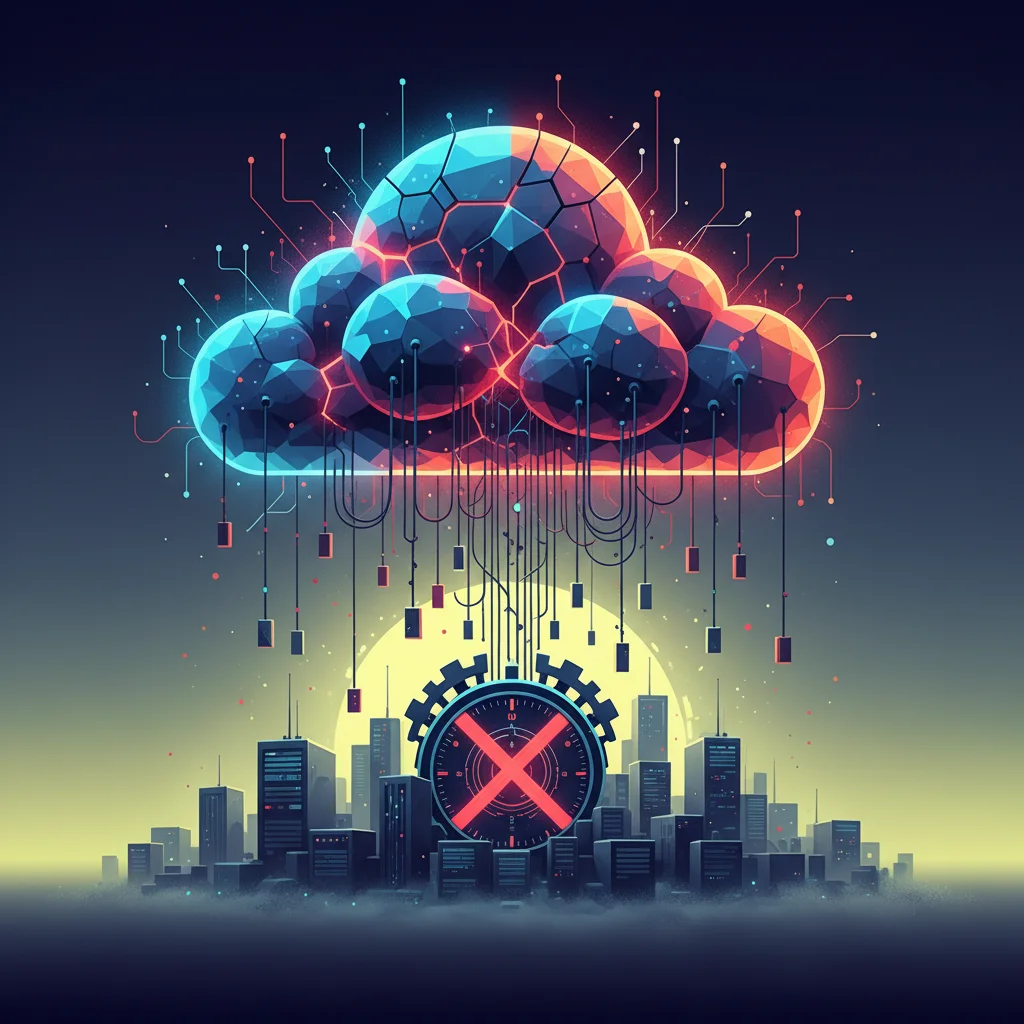
The Day the Cloud Stood Still: Is Our Big Tech Habit a Ticking Time Bomb?
The Internet Went Quiet. Did You Notice?
It was a Monday like any other, until it wasn’t. Suddenly, your favorite productivity app freezes. The streaming service you use to decompress after work won’t load. Your smart home devices become decidedly… dumb. For millions, this digital disruption was a reality during a massive outage at Amazon Web Services (AWS), the silent giant that powers a shocking amount of the internet. The incident wasn’t just an inconvenience; it was a stark reminder of a question that the tech world has been nervously whispering for years: Is our overwhelming reliance on a handful of US tech titans a feature or a fatal flaw of our digital age?
This isn’t just about Amazon. The digital infrastructure that underpins modern society—from banking and healthcare to entertainment and government—is largely built on the foundations laid by AWS, Microsoft Azure, and Google Cloud. These platforms have fueled a decade of unprecedented innovation, enabling startups to scale globally overnight and powering the complex computations behind the artificial intelligence revolution. But as the recent outage showed, when one of these pillars wobbles, the entire digital cathedral can shake. Let’s peel back the layers of the cloud, explore the trade-offs we’ve made, and ask what this means for developers, entrepreneurs, and anyone who depends on a stable digital world.
The Invisible Landlord: What is the Cloud, Really?
For many, the “cloud” is an abstract concept—a magical place where photos and files just… exist. In reality, it’s a network of millions of powerful physical servers housed in massive, highly secure data centers around the globe. Companies like AWS are essentially the world’s biggest digital landlords. Instead of buying and managing their own expensive server hardware, businesses can rent computing power, storage, and a vast suite of other services on a pay-as-you-go basis. This model, often called Infrastructure-as-a-Service (IaaS), has been a game-changer.
It has democratized access to enterprise-grade technology. A small team of developers with a brilliant idea for a new SaaS (Software-as-a-Service) application no longer needs millions in venture capital for hardware. They can spin up servers with a few clicks, leverage sophisticated machine learning models, and deploy their software to a global audience in minutes. This is the engine that has powered countless tech success stories. But this convenience has led to immense market concentration. Just three companies dominate this critical landscape.
To put this dominance into perspective, here’s a look at the global cloud infrastructure market share from the first quarter of 2024.
| Cloud Provider | Market Share (Q1 2024) | Key Strengths |
|---|---|---|
| Amazon Web Services (AWS) | 31% | Market pioneer, extensive service portfolio, strong enterprise adoption |
| Microsoft Azure | 25% | Strong in hybrid cloud, deep integration with Microsoft’s enterprise software |
| Google Cloud Platform (GCP) | 11% | Leadership in AI, machine learning, data analytics, and containerization |
| Other Providers | 33% | Niche players, regional specialists, and smaller providers |
Data sourced from Synergy Research Group’s Q1 2024 analysis.
As the table shows, nearly 70% of the public cloud market is controlled by just three US-based companies. This concentration is the source of both incredible power and significant risk.
WPP's 0M Bet on Google AI: Is This the End of Marketing As We Know It?
The Centralization Conundrum: A Double-Edged Sword
The debate over big tech reliance isn’t black and white. The very reasons we’ve flocked to these platforms are the same reasons we should be cautious. It’s a classic double-edged sword.
The Bright Side: Innovation at Unprecedented Scale
Let’s be clear: the world runs on AWS, Azure, and GCP for good reason. The level of investment these companies pour into research and development is staggering. This leads to:
- Advanced AI and Machine Learning: Developing cutting-edge AI models from scratch is incredibly expensive and complex. Cloud providers offer these capabilities as a service, allowing startups and even established companies to integrate powerful features like natural language processing and computer vision into their products without needing a team of PhDs.
- Robust Cybersecurity: While no system is impenetrable, the hyperscalers employ some of the world’s top cybersecurity experts. They can detect and mitigate threats at a scale that most individual companies could never hope to match. For many businesses, moving to the cloud actually improves their security posture.
- Developer Productivity: These platforms are more than just servers. They are rich ecosystems of tools, APIs, and services that streamline the entire programming and software development lifecycle. This accelerates the pace of innovation and allows developers to focus on building great products rather than managing infrastructure.
The Dark Side: A Fragile Foundation
The recent outage threw the downsides into sharp relief. When your entire business, or a significant portion of the global economy, relies on a single vendor, you inherit their problems.
- Single Point of Failure: This is the most obvious risk. A bug in a core service, a physical data center issue, or a targeted cyberattack can create a cascading failure that takes down thousands of services simultaneously. The internet, designed to be a decentralized network, has developed a highly centralized heart.
- Geopolitical Chessboard: The fact that the dominant players are US-based is not trivial. It raises complex questions about data sovereignty, international law, and the potential for services to be disrupted by political tensions. Nations around the world are becoming increasingly wary of having their critical digital infrastructure controlled by foreign entities (source).
- Vendor Lock-in and Stifled Competition: As companies build more of their operations on a specific cloud’s proprietary services, it becomes increasingly difficult and expensive to switch. This “vendor lock-in” can reduce negotiating power and potentially stifle long-term competition from smaller, innovative cloud providers.
Building a More Resilient Future: What’s the Plan B?
So, if complete independence from big tech is unrealistic, what are the practical steps that businesses and developers can take to mitigate the risks? The answer lies in building a smarter, more resilient architecture.
Beyond the Blackout: Vodafone’s Outage and the Hidden Fragility of Modern Software
For Developers and Tech Professionals: Architecting for Resilience
The responsibility often falls on the shoulders of those writing the code and designing the systems. It’s time to move from a “cloud-native” to a “cloud-agnostic” or “multi-cloud” mindset where possible.
- Embrace Multi-Cloud Strategy: This doesn’t mean running the same application across two clouds simultaneously, which is incredibly complex. It can mean using different clouds for different workloads. For example, use AWS for core compute, Google Cloud for its specialized AI services, and a third provider like Cloudflare for DNS and edge services. This diversification spreads your risk.
- Design for Regional Failover: Even within a single provider like AWS, don’t rely on a single data center region. Architect your applications to automatically failover to a different geographic region if one goes down. This is a fundamental principle of disaster recovery.
- Leverage Open-Source Software: Whenever possible, use open-source tools and platforms (like Kubernetes for container orchestration) that can run on any cloud provider. This reduces vendor lock-in and makes your software more portable.
For Entrepreneurs and Startups: A Pragmatic Approach
If you’re a startup, the benefits of going all-in on a single cloud provider are immense. You get speed, simplicity, and often free credits. A complex multi-cloud setup is a distraction you can’t afford. But you can still be smart.
- Conduct a Risk-Benefit Analysis: How much does a few hours of downtime truly cost your business? For an early-stage SaaS company, it might be an annoyance. For a fintech platform processing payments, it’s catastrophic. Tailor your resilience strategy to your business needs.
- Keep Your Options Open: Avoid over-reliance on a provider’s most proprietary, niche services early on. Stick to the “basics” of compute, storage, and databases that have equivalents on other platforms. This gives you flexibility later.
- Separate Your Control Plane: A simple first step is to host your DNS with a third-party provider. That way, if your main cloud host goes down, you can at least redirect traffic to a static maintenance page or a backup site, maintaining communication with your users.
Your Cloud is Down: Why Your Best Defense Against AI Cyberattacks is a Pen and Paper
The Path Forward: Beyond Dependence
The AWS outage wasn’t the first major cloud disruption, and it certainly won’t be the last. These incidents are no longer just technical problems; they are societal ones. They force us to confront the highly concentrated foundation upon which our digital world is built. The solution isn’t to dismantle the incredible platforms that have enabled so much innovation, but to build a more thoughtful and resilient layer on top of them.
The future of digital infrastructure will likely be a hybrid one—a world where businesses strategically use the strengths of multiple providers, where open standards prevent deep lock-in, and where designing for failure is a core part of the programming curriculum. The question is no longer *if* we are too reliant on big tech, but rather, what are we going to do about it? The stability of our increasingly digital economy depends on our answer.


